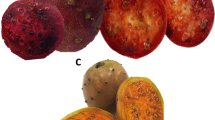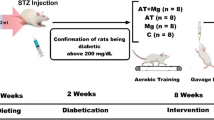Abstract
The aim of the present study was to investigate the browning effects mechanism of Smilax china L. polyphenols (SCLP) and its monomer. In this study, polyphenols (SCLP, engeletin, quercetin and caffeic acid) markedly suppressed lipid accumulation. Polyphenols significantly up-graded the expression of protein kinase A (PKA), adipose triglyceride lipase (ATGL), peroxisome proliferators-activated receptors alpha (PPARα), carnitine palmitoyl transferase (CPT) and acyl-CoA oxidase (ACO) to promote lipolysis and β-oxidation. Moreover, polyphenols greatly enhanced mitochondrial biogenesis in adipocytes, as demonstrated by the expression of Nrf1 and Tfam were up-regulated. Furthermore, polyphenols treatment greatly up-regulated the browning program in adipocytes by increased brown-specific genes and proteins uncoupling protein 1 (UCP-1), peroxisome proliferator-activated receptor gamma coactivator-1 alpha (PGC-1α) and PR domain containing 16 (PRDM16), as well as beige-specific genes (Tmem26, Tbx1, CD137, Cited1), especially engeletin. Further research found that the brown-specific markers were decreased by antagonist treatment of AMPK or β3-AR, but polyphenols treatment reversed the effect of antagonists and improved the expression of UCP-1, PRDM16 and PGC-1α. In conclusion, these results indicated that polyphenols stimulate browning in adipocytes via activation of the β3-AR/AMPK signaling pathway, and SCLP and its monomer may be worth investigating to prevent obesity.








Similar content being viewed by others
Data Availability
All data generated or analysed during this study are included in this published article (and its supplementary information files).
Abbreviations
- AMPKα:
-
AMP-activated protein kinase alpha
- AL:
-
Astilbin
- BAT:
-
Brown adipose tissue
- CA:
-
Caffeic acid
- CPT:
-
Carnitine palmitoyltransferase
- DMEM:
-
Dulbecco’s modified Eagle’s medium
- EL:
-
Engeletin
- FBS:
-
Fetal Bovine Serum
- GAPDH:
-
Glyceraldehyde 3-phosphate dehydrogenase
- IBMX:
-
3-isobutyl-1-methylxanthine
- Nrf1:
-
Nuclear respiratory factor 1
- PBS:
-
Phosphate-buffered saline
- PKA:
-
Protein kinase A
- PGC-1α :
-
Peroxisome proliferator-activated receptor gamma coactivator-1 alpha
- PRDM16:
-
PR domain containing 16
- PPARα :
-
Peroxisome proliferator-activated receptor alpha
- QC:
-
Quercetin
- RT-PCR:
-
Quantitative real-time reverse transcription polymerase Chain reaction
- SD:
-
Standard deviation
- SCLP:
-
Smilax china L
- Tmem26:
-
Gene encoding transmembrane protein 26
- Tfam:
-
Mitochondrial transcription factor A
- TG:
-
Triglyceride
- UCP-1:
-
Uncoupling protein-1
- WAT:
-
White adipose tissue
References
Lega I, Lipscombe L (2020) Review: diabetes, obesity, and cancer-pathophysiology and clinical implications. Endocr Rev 41(1). https://doi.org/10.1210/endrev/bnz014
Rusinek H, Convit A (2014) Obesity: cerebral damage in obesity-associated metabolic syndrome. Nat Rev Endocrinol 10(11):642–624. https://doi.org/10.1038/nrendo.2014.141
Chen L, Chen Y, Cheng K et al (2018) Antiobesity effect of Lactobacillus reuteri 263 associated with energy metabolism remodeling of white adipose tissue in high-energy-diet-fed rats. J Nutr Biochem 54:87–94. https://doi.org/10.1016/j.jnutbio.2017.11.004
Ali AT, Hochfeld WE, Myburgh R, Michael S (2013) Adipocyte and adipogenesis. Eur J Cell Biol 92(6/7):229–236
Lee Y, Jung Y, Choi D (2014) Recent advance in brown adipose physiology and its therapeutic potential. Exp Mol Med 46:e78. https://doi.org/10.1038/emm.2013.163
Park PJ, Cho JY, Cho EG (2017) Specific visible radiation facilitates lipolysis in mature 3T3-L1 adipocytes via rhodopsin-dependent β3-adrenergic signaling. Eur J Cell Biol 96 (4). https://doi.org/10.1016/j.ejcb. 2017.03.015
Okla M, Kim J, Koehler K, Chung S (2017) Dietary factors promoting brown and beige fat development and thermogenesis. Adv Nutr 8(3):473–483. https://doi.org/10.3945/an.116.014332
Roman S, Agil A, Peran M et al (2015) Brown adipose tissue and novel therapeutic approaches to treat metabolic disorders. Transl Res 165(4):464–479. https://doi.org/10.1016/j.trsl.2014.11.002
Sveidahl Johansen O, Ma T, Hansen JB et al (2021) Lipolysis drives expression of the constitutively active receptor GPR3 to induce adipose thermogenesis. Cell 184:3502–3518. https://doi.org/10.1016/j.cell.2021.04.037
Li Y, Wang D, Ping X et al (2022) Local hyperthermia therapy induces browning of white fat and treats obesity. Cell 185(6):949–966. https://doi.org/10.1016/j.cell.2022.02.004
Fernández-Verdejo R, Marlatt K, Ravussin E, Galgani J (2019) Contribution of brown adipose tissue to human energy metabolism. Mol Aspects Med 68:82–89. https://doi.org/10.1016/j.mam.2019.07.003
Kozak L, Anunciado-Koza R (2008) UCP1: its involvement and utility in obesity. Int J Obes S32–38. https://doi.org/10.1038/ijo.2008.236
Wang J, Zhang L, Dong L et al (2019) 6-Gingerol, a functional polyphenol of ginger, promotes browning through an ampk-dependent pathway in 3t3-l1 adipocytes. J Agric Food Chem 67(51):14056–14065. https://doi.org/10.1021/acs.jafc.9b05072
Xu Z, You W, Liu J, Wang Y, Shan T (2020) Elucidating the regulatory role of melatonin in brown, white, and beige adipocytes. Adv Nutr 11(2):447–460. https://doi.org/10.1093/advances/nmz070
Zhao B, Liu M, Liu H et al (2021) Zeaxanthin promotes browning by enhancing mitochondrial biogenesis through the PKA pathway in 3T3-L1 adipocytes. Food Funct 12(14):6283–6293. https://doi.org/10.1039/d1fo00524c
Harms M, Seale P (2013) Brown and beige fat: development, function and therapeutic potential. Nat Med 19(10):1252–1263. https://doi.org/10.1038/nm.3361
Lidell ME, Betz MJ, Leinhard OD et al (2013) Evidence for two types of brown adipose tissue in humans. Nat Med 19(5):631–634. https://doi.org/10.1038/nm.3017
López M, Tena-Sempere M (2017) Estradiol effects on hypothalamic AMPK and BAT thermogenesis: a gateway for obesity treatment? Pharmacol Ther 178:109–122. https://doi.org/10.1016/j.pharmthera.2017. 03.014
Kim OY, Chung JY, Song J (2019) Effect of resveratrol on adipokines and myokines involved in fat browning: Perspectives in healthy weight against obesity. Pharmacol Res 148:104411. https://doi.org/10.1016/j.phrs.2019.104411
Wu LS, Wang XJ, Wang H et al (2010) Cytotoxic polyphenols against breast tumor cell in Smilax china L. J Ethnopharmacol 130(3):460–464. https://doi.org/10.1016/j.jep.2010.05.032
Zhao X, Chen R, Shi Y, Zhang X, Xia D (2020) Antioxidant and anti-inflammatory activities of six flavonoids from smilax glabra roxb. Molecules 25(22):5295. https://doi.org/10.3390/molecules25225295
Yang L, Zhao Y, Pan Y, Li D, Zheng G (2019) Dietary supplement of Smilax china L. ethanol extract alleviates the lipid accumulation by activating AMPK pathways in high-fat diet fed mice. Nutr Metabo 16(1):6. https://doi.org/10.1186/s12986-019-0333-z
Li X, Yang L, Xu M, Qiao G, Zheng G (2021) Smilax china L. polyphenols alleviates obesity and inflammation by modulating gut microbiota in high fat/high sucrose diet-fed C57BL/6J mice. J Funct Foods 77(8):104332. https://doi.org/10.1016/j.jff.2020.104332
Li X, Yang L, Li J, Lin L, Zheng GD (2021) A flavonoid-rich Smilax china L. extract prevents obesity by upregulating the adiponectin-receptor/AMPK signalling pathway and modulating the gut microbiota in mice. Food Funct 12:5862–5875. https://doi.org/10.1039/d1fo00282a
Xu M, Xue H, Li X et al (2019) Chemical composition, antibacterial properties, and mechanism of Smilax china L. polyphenols. Appl Microbiol Biotechnol 103(21–22):9013–9022. https://doi.org/10.1007/s00253-019-10100-0
Rafiei H, Omidian K, Bandy B (2017) Comparison of dietary polyphenols for protection against molecular mechanisms underlying nonalcoholic fatty liver disease in a cell model of steatosis. Mol Nutr Food Res 1600781. https://doi.org/10.1002/mnfr.201600781
Chouchani E, Kazak L, Spiegelman B (2019) New advances in adaptive thermogenesis: UCP1 and beyond. Cell Metab 29(1):27–37. https://doi.org/10.1016/j.cmet.2018.11.002
Fan H, Ding R, Liu W et al (2021) Heat shock protein 22 modulates NRF1/TFAM-dependent mitochondrial biogenesis and DRP1-sparked mitochondrial apoptosis through AMPK-PGC1α signaling pathway to alleviate the early brain injury of subarachnoid hemorrhage in rats. Redox Biol 40:101856. https://doi.org/10.1016/j.redox.2021.101856
Evenocheck A, Rhee Y, Hall C (2020) Do health promoting compounds of flaxseed attenuate weight gain via modulation of obesity gene expression? Plant Foods Hum Nutr 75:441–445. https://doi.org/10.1007/s11130-020-00825-z
Seo Y, Jin H, Lee K et al (2019) Cardamonin suppresses lipogenesis by activating protein kinase A-mediated browning of 3T3-L1 cells. Phytomedicine 65:153064. https://doi.org/10.1016/j.phymed.2019. 153064
Bogacka I, Gettys T, de Jonge L et al (2007) The effect of beta-adrenergic and peroxisome proliferator-activated receptor-gamma stimulation on target genes related to lipid metabolism in human subcutaneous adipose tissue. Diabetes Care 30(5):1179–1186. https://doi.org/10.2337/dc06-1962
Medina E, Oberheu K, Polusani S et al (2014) PKA/AMPK signaling in relation to adiponectin’s antiproliferative effect on multiple myeloma cells. Leukemia 28(10):2080–2089. https://doi.org/10.1038/leu.2014.112
Fan L, Xu H, Yang R, Zang Y, Chen J, Qin H (2019) Combination of capsaicin and capsiate induces browning in 3t3-l1 white adipocytes via activation of the peroxisome proliferator-activated receptor γ/β-adrenergic receptor signaling pathways. J Agric Food Chem 67(22):6232–6240. https://doi.org/10.1021/acs.jafc.9b02191
Peng W, Xiao G, Li B, Guo Y, Guo L, Tang Q (2021) l-Theanine activates the browning of white adipose tissue through the AMPK/α-ketoglutarate/Prdm16 axis and ameliorates diet-induced obesity in mice. Diabetes 70(7):1458–1472. https://doi.org/10.2337/db20-1210
Seale P (2015) Transcriptional regulatory circuits controlling brown fat development and activation. Diabetes 64(7):2369–2375. https://doi.org/10.2337/db15-0203
Acknowledgements
This work was supported by the National Natural Science Foundation of China (No. 82060165, 81760157).
Author information
Authors and Affiliations
Contributions
Li Kong: Data curation, formal analysis, investigation, and writing–original draft preparation. Wenkai Zhang: Methodology. Shanshan Liu: Investigation. Zhen Zhong: Data curation. Guodong Zheng: Funding acquisition and resources, designed the research, writing–review and editing, project administration, and supervision. All authors reviewed and approved the final version of the manuscript.
Corresponding author
Ethics declarations
Conflict of Interest
The authors declare that they have no conflicts of interest.
Additional information
Publisher’s Note
Springer Nature remains neutral with regard to jurisdictional claims in published maps and institutional affiliations.
Electronic Supplementary Material
Below is the link to the electronic supplementary material.
Rights and permissions
Springer Nature or its licensor holds exclusive rights to this article under a publishing agreement with the author(s) or other rightsholder(s); author self-archiving of the accepted manuscript version of this article is solely governed by the terms of such publishing agreement and applicable law.
About this article
Cite this article
Kong, L., Zhang, W., Liu, S. et al. Quercetin, Engelitin and Caffeic Acid of Smilax china L. Polyphenols, Stimulate 3T3-L1 Adipocytes to Brown-like Adipocytes Via β3-AR/AMPK Signaling Pathway. Plant Foods Hum Nutr 77, 529–537 (2022). https://doi.org/10.1007/s11130-022-00996-x
Received:
Revised:
Accepted:
Published:
Issue Date:
DOI: https://doi.org/10.1007/s11130-022-00996-x




